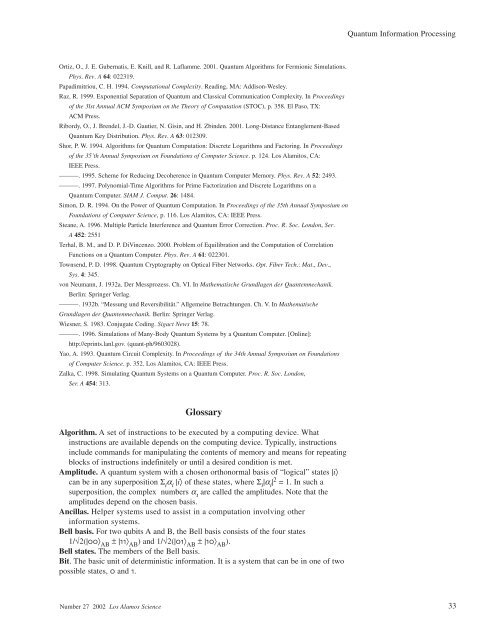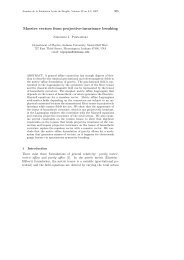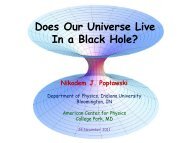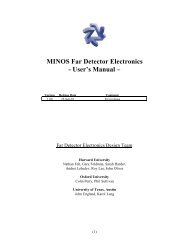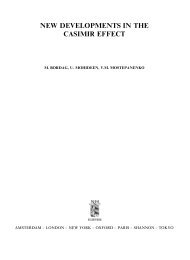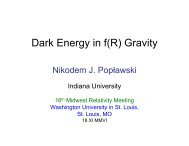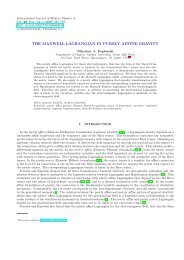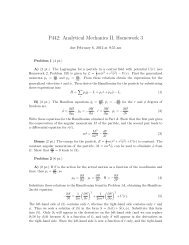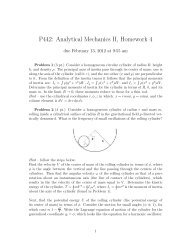Quantum Information Processing
Quantum Information Processing
Quantum Information Processing
Create successful ePaper yourself
Turn your PDF publications into a flip-book with our unique Google optimized e-Paper software.
Ortiz, O., J. E. Gubernatis, E. Knill, and R. Laflamme. 2001. <strong>Quantum</strong> Algorithms for Fermionic Simulations.<br />
Phys. Rev. A 64: 022319.<br />
Papadimitriou, C. H. 1994. Computational Complexity. Reading, MA: Addison-Wesley.<br />
Raz, R. 1999. Exponential Separation of <strong>Quantum</strong> and Classical Communication Complexity. In Proceedings<br />
of the 3lst Annual ACM Symposium on the Theory of Computation (STOC), p. 358. El Paso, TX:<br />
ACM Press.<br />
Ribordy, O., J. Brendel, J.-D. Gautier, N. Gisin, and H. Zbinden. 2001. Long-Distance Entanglement-Based<br />
<strong>Quantum</strong> Key Distribution. Phys. Rev. A 63: 012309.<br />
Shor, P. W. 1994. Algorithms for <strong>Quantum</strong> Computation: Discrete Logarithms and Factoring. In Proceedings<br />
of the 35’th Annual Symposium on Foundations of Computer Science. p. 124. Los Alamitos, CA:<br />
IEEE Press.<br />
———. 1995. Scheme for Reducing Decoherence in <strong>Quantum</strong> Computer Memory. Phys. Rev. A 52: 2493.<br />
———. 1997. Polynomial-Time Algorithms for Prime Factorization and Discrete Logarithms on a<br />
<strong>Quantum</strong> Computer. SIAM J. Comput. 26: 1484.<br />
Simon, D. R. 1994. On the Power of <strong>Quantum</strong> Computation. In Proceedings of the 35th Annual Symposium on<br />
Foundations of Computer Science, p. 116. Los Alamitos, CA: IEEE Press.<br />
Steane, A. 1996. Multiple Particle Interference and <strong>Quantum</strong> Error Correction. Proc. R. Soc. London, Ser.<br />
A 452: 2551<br />
Terhal, B. M., and D. P. DiVincenzo. 2000. Problem of Equilibration and the Computation of Correlation<br />
Functions on a <strong>Quantum</strong> Computer. Phys. Rev. A 61: 022301.<br />
Townsend, P. D. 1998. <strong>Quantum</strong> Cryptography on Optical Fiber Networks. Opt. Fiber Tech.: Mat., Dev.,<br />
Sys. 4: 345.<br />
von Neumann, J. 1932a. Der Messprozess. Ch. VI. In Mathematische Grundlagen der Quantenmechanik.<br />
Berlin: Springer Verlag.<br />
———. 1932b. “Messung und Reversibilität.” Allgemeine Betrachtungen. Ch. V. In Mathematische<br />
Grundlagen der Quantenmechanik. Berlin: Springer Verlag.<br />
Wiesner, S. 1983. Conjugate Coding. Sigact News 15: 78.<br />
———. 1996. Simulations of Many-Body <strong>Quantum</strong> Systems by a <strong>Quantum</strong> Computer. [Online]:<br />
http://eprints.lanl.gov. (quant-ph/9603028).<br />
Yao, A. 1993. <strong>Quantum</strong> Circuit Complexity. In Proceedings of the 34th Annual Symposium on Foundations<br />
of Computer Science. p. 352. Los Alamitos, CA: IEEE Press.<br />
Zalka, C. 1998. Simulating <strong>Quantum</strong> Systems on a <strong>Quantum</strong> Computer. Proc. R. Soc. London,<br />
Ser. A 454: 313.<br />
Glossary<br />
Algorithm. A set of instructions to be executed by a computing device. What<br />
instructions are available depends on the computing device. Typically, instructions<br />
include commands for manipulating the contents of memory and means for repeating<br />
blocks of instructions indefinitely or until a desired condition is met.<br />
Amplitude. A quantum system with a chosen orthonormal basis of “logical” states |i〉<br />
can be in any superposition Σ i α i |i〉 of these states, where Σ i |α i | 2 = 1. In such a<br />
superposition, the complex numbers α ι are called the amplitudes. Note that the<br />
amplitudes depend on the chosen basis.<br />
Ancillas. Helper systems used to assist in a computation involving other<br />
information systems.<br />
Bell basis. For two qubits A and B, the Bell basis consists of the four states<br />
1/√2(|〉 AB ±|〉 AB ) and 1/√2(|〉 AB ±|〉 AB ).<br />
Bell states. The members of the Bell basis.<br />
Bit. The basic unit of deterministic information. It is a system that can be in one of two<br />
possible states, and .<br />
<strong>Quantum</strong> <strong>Information</strong> <strong>Processing</strong><br />
Number 27 2002 Los Alamos Science 33


